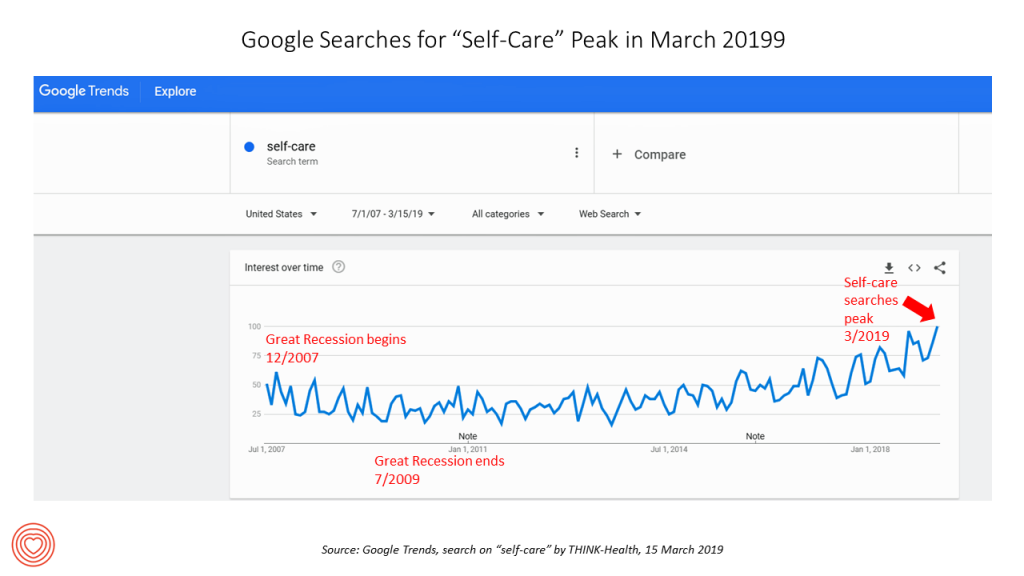
Today, the number of searches on Google using the phrase “self-care” reached a high, shown in the line graph I created on Google Trends and marked up in red. A Google search overall yielded over 2 billion results.
I started this search when the Great Recession began in the U.S. in December 2007, and tracked “self-care” searches to today, 15 March 2019.
I ran this little test because I’m speaking on Monday 18 March at the annual meeting of the Consumer Healthcare Products Association. CHPA was founded in 1881 as the “Proprietary Association.” In 1989, over 100 years later, the organization was renamed the “Nonprescription Drug Manufacturers Association,” and finally in 1999, its current name which took the trade group beyond “nonprescription drugs” to include a broader portfolio of products people use for self-health.
I’ll be speaking about the “disruptive” new retail health era in the larger context of the evolution of self-care. The Google Trends line drawing illustrates the fact that consumers are embracing the concept of self-care more than ever (or at least since the advent of the Great Recession), searching the phrase on Google with a variety of intentions.
As I dug in deeper to these intentions via Google searches on self-care, I found a broad range of queries covering peoples’ uniquely personal definitions of “health.” These include physical health (“paging Dr. Google” on symptoms, specific conditions, and prescription drugs), mental health (across all age groups, but especially pronounced among younger people), nutrition and food preparation advice, and a lot about dealing with stress and sleep. In this moment, there’s a lot on meditation and mindfulness, exclusion diets, and Gwyneth Paltrow and Goop: pro and con.
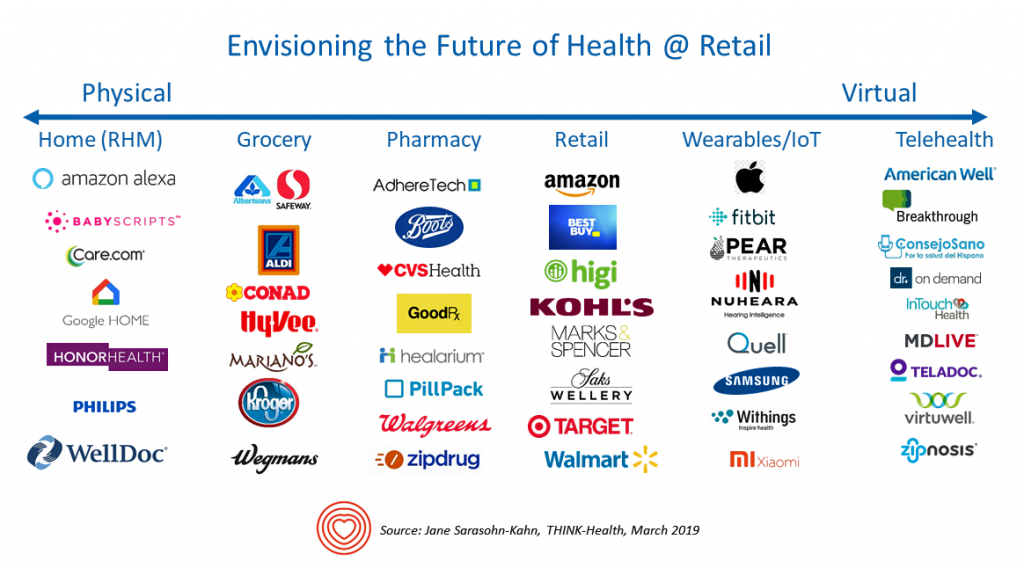 Self-care, the World Health Organization tells us, is “what people do for themselves to establish and maintain health, and to prevent and deal with illness. It is a broad concept encompassing hygiene, nutrition, lifestyle, environmental factors, social habits, socio-economic factors, and self-medication.”
Self-care, the World Health Organization tells us, is “what people do for themselves to establish and maintain health, and to prevent and deal with illness. It is a broad concept encompassing hygiene, nutrition, lifestyle, environmental factors, social habits, socio-economic factors, and self-medication.”
Well, then…that’s a full-time job for each of us, isn’t it?
This all-encompassing definition speaks to the opportunity for health@retail, as I see it, turbocharged by broadband connectivity and digital health tools that I envision in the second chart here. I’ll be discussing the driving forces shaping the evolving health consumer (hint: the Great Recession did indeed begin to re-shape people as more demanding, empowered, and DIY engaged), the emerging platforms for self-care, and the role of data, AI and privacy. Then I’ll dive deeper into the opportunities for consumers to improve their hearing and manage pain when I meet on the stage with Justin Miller, CEO and Founder of Nuheara, and Dr. Shai Gozani, CEO and President of NeuroMetrix, maker of the Quell device.
Google Trends for self-care provide but one key data point making my case for self-care among people seeking more control over health, costs, and care.
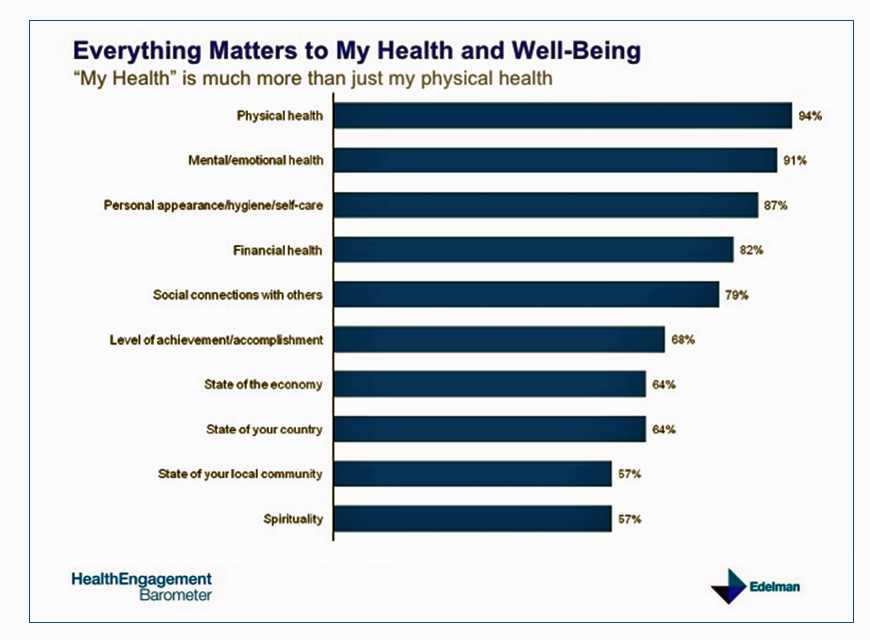 Health Populi’s Hot Points: This weekend at Cosmoprof in Bologna, stakeholders are meeting to brainstorm concepts and product ideas on the beauty industry. So many of us are looking at the role of beauty in health and wellness, beyond “cosmetics.”
Health Populi’s Hot Points: This weekend at Cosmoprof in Bologna, stakeholders are meeting to brainstorm concepts and product ideas on the beauty industry. So many of us are looking at the role of beauty in health and wellness, beyond “cosmetics.”
This, too, is part of self-care, and retailers have certainly caught on to consumers’ demand for more holistic and realistic beauty — among both women and men. If you don’t believe me on the latter, check out this analysis on the growing demand for, ahem, “manscaping below the belt” in an article this week in Marketing Daily.
We learned in an early iteration of the Edelman Health Engagement Barometer that how we feel about our appearance is a key component of how we define our health and well-being — ranking closely after physical health and mental and emotional health, and just ahead of financial wellness. Self-care is about these four things, and look below financial health — because people self-define health, too, the way WHO does — in terms of social connections (where evidence continues to grow proving the relationship between loneliness and physical health), level of self-accomplishment, state of the economy (financial stress beyond the personal bank account), the state of the country, the state of one’s community, and spirituality. Political stress is certainly a feature of contemporary life in 2019, whether we live in Great Britain facing #Brexit stress this week, Venezuela dealing with a corrupt national government, France facing #YellowVests, or the USA split into factions in this very moment.
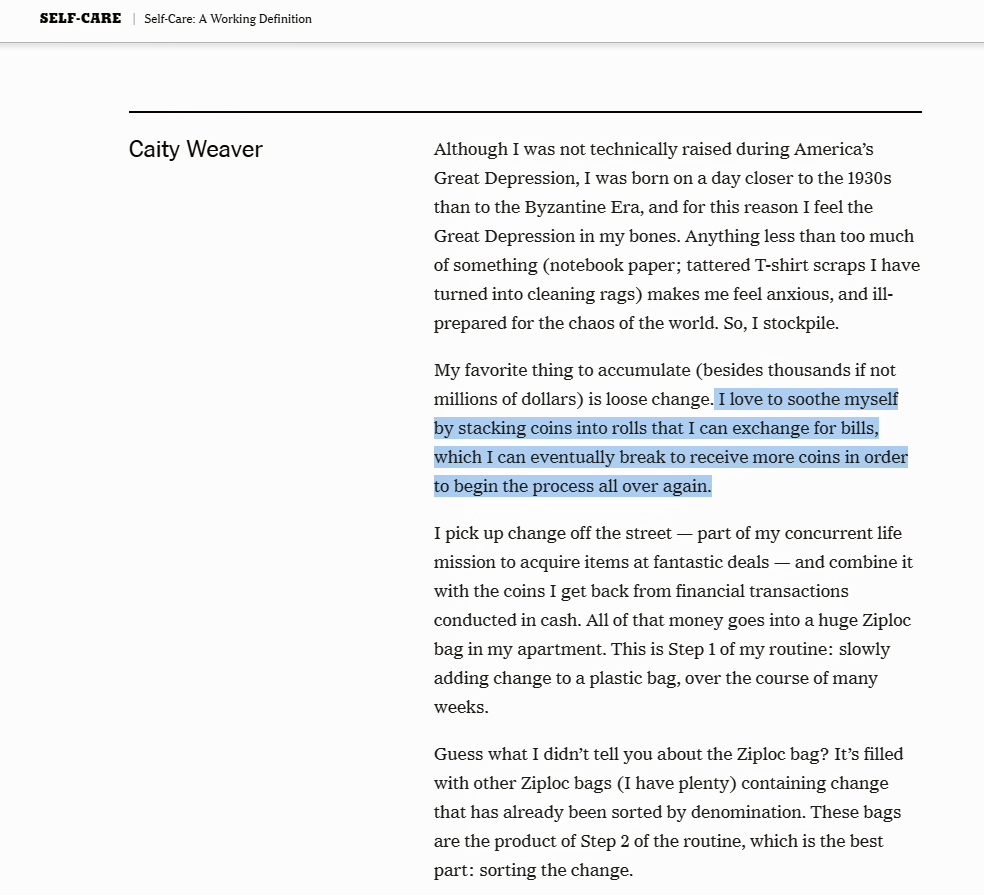 As a short-term salve, check out this special digital section that staff from the New York Times published online in November 2018. It’s a delightful, insightful, often moving curation of insights from folks working at the Times who shared their own concepts and memories on self-care. The paragraphs shown here in the last graphic from Caity Weaver is one snippet from Self-Care: A Working Definition. Caity talks about the therapeutic benefit of stacking loose change.
As a short-term salve, check out this special digital section that staff from the New York Times published online in November 2018. It’s a delightful, insightful, often moving curation of insights from folks working at the Times who shared their own concepts and memories on self-care. The paragraphs shown here in the last graphic from Caity Weaver is one snippet from Self-Care: A Working Definition. Caity talks about the therapeutic benefit of stacking loose change.
I love how Caity weaves together components of health that aren’t obvious, but so personal to her: the meditative nature of the stacking of the coins, the happiness she gets from picking change off the street, and the financial wellness bolstered by exchanging the change for bills at the bank.
Self-care@retail is everywhere.


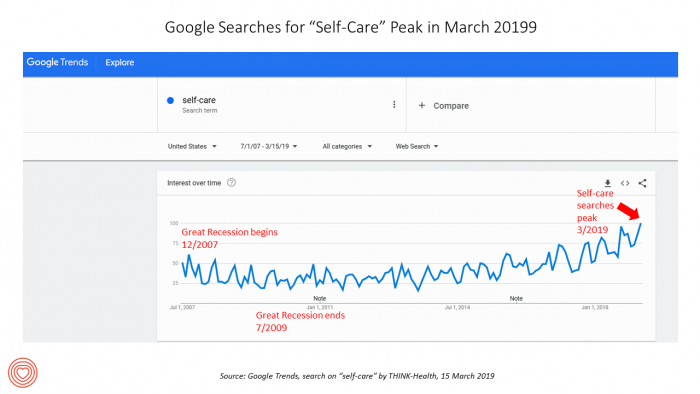


 Thank you FeedSpot for
Thank you FeedSpot for